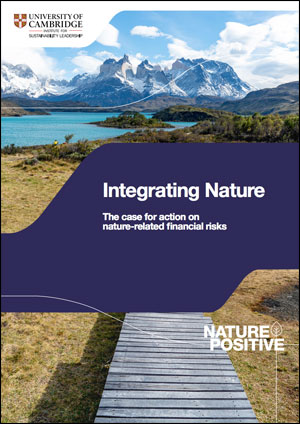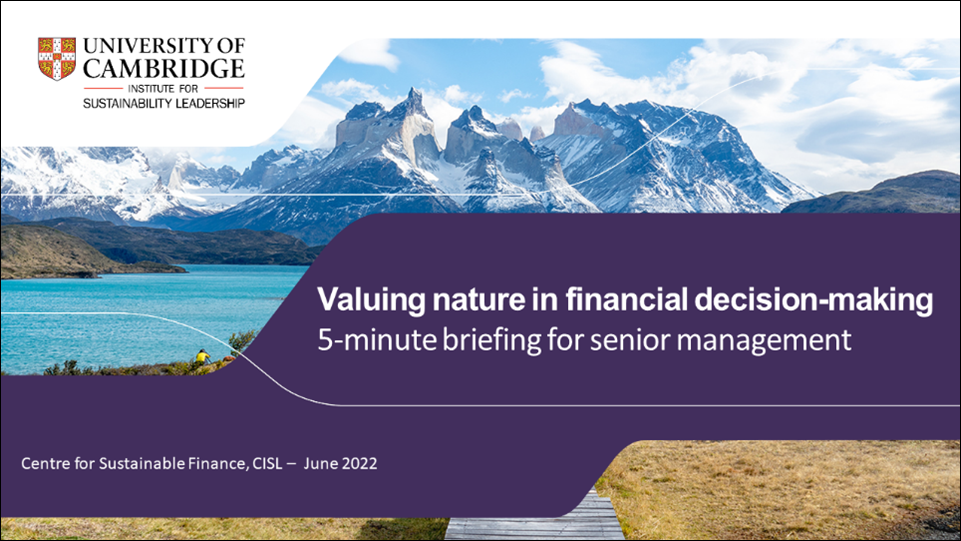What are nature-related financial risks?
Leading companies recognise that a prosperous business relies upon nature and the ecosystem services it provides. They also recognise that the ‘E’ in ‘ESG’ is about protecting our biodiversity and natural capital, as well as our climate, and that the two are interlinked.
Nature’s health is under pressure from global trends in consumption, structural inequalities and economic growth.
This creates long-term risks to business, citizens and wider society who depend on nature. These pose nature-related financial risks to financial institutions.
Empowering financial institutions to integrate nature into financial decision making
The CISL Centre for Sustainable Finance are working closely with member banks and asset managers to:
- Determine a common language and framework
- Identify and assess the financial risks of nature loss
- Measure and manage such risks
To achieve these two objectives CISL, financial institutions and academics have co-created frameworks and use cases. By doing so, we aim to:
- Enable the financial community to integrate nature loss into decision-making
- Catalyse the reallocation of capital to economic activities that protect and restore nature
Why and how to integrate nature into finance
We depend on the goods and services nature provides. With one fifth of nature’s ecosystems on the verge of collapse, action is needed today.
The applied research programme began by mapping the financial materiality of biodiversity and land degradation, underlining why action is needed.
The next step saw CISL work with academics and financial institutions to create the Handbook for Nature-related Financial Risks. The Handbook explains key concepts linked to nature loss and financial risk and provides a framework for risk identification. It is designed for financial practitioners with limited prior knowledge of how the decline of nature can put their institution at financial risk.
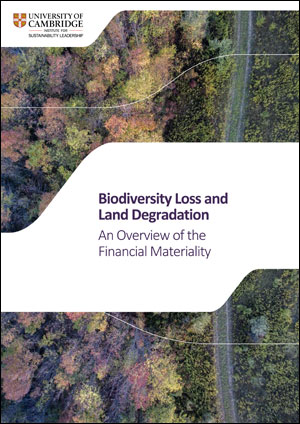
Financial materiality of biodiversity loss and land degradation
Business briefings detailing the current ways that biodiversity loss and land degradation are financially material.
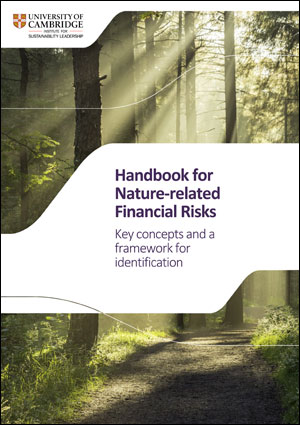
Handbook for Nature-related Financial Risks
Explaining key concepts and providing a framework for risk identification.
Using the Handbook, member financial institutions of the Banking Environment Initiative and Investment Leaders Group collaborated with CISL on use cases that quantify and assess specific nature-related financial risks. These five use cases provide further evidence of the materiality of financial risks, answering the question of why and how to integrate nature into financial decision-making.
Use cases: assessing nature-related financial risks

How soil degradation amplifies the financial vulnerability of listed
companies in the agricultural value
chain (Robeco)

The EU Farm to Fork Strategy and Fertiliser Companies (Deutsche Bank and Union Bancaire Privée (UBP))
The purpose of these use cases is to enable and galvanise further assessments of nature-related risk across the financial system. Detailing the risk assessment process aims to show ways in which the wider financial industry can make such assessments of their own. All financial firms are vulnerable to nature-related financial risks; and the financial materiality of nature loss evidenced constitutes an urgent call to action.
The case for action
To accompany the use cases, CISL published the Integrating Nature: The case for action on nature-related financial risks. Bringing together key evidence from the research, the report is designed to support senior management at financial institutions in understanding and acting to address nature-related risk, deploying resources and building resilience for their portfolios and institution.
Now is the time for the financial sector to lead; integrating nature into decision-making, managing nature-related risks and catalysing capital reallocation that protects and restores nature.
The integration of nature into financial decision-making can refresh the relationship between people and planet. Identifying and assessing nature-related financial risks are key steps for creating an economy with nature at its heart.
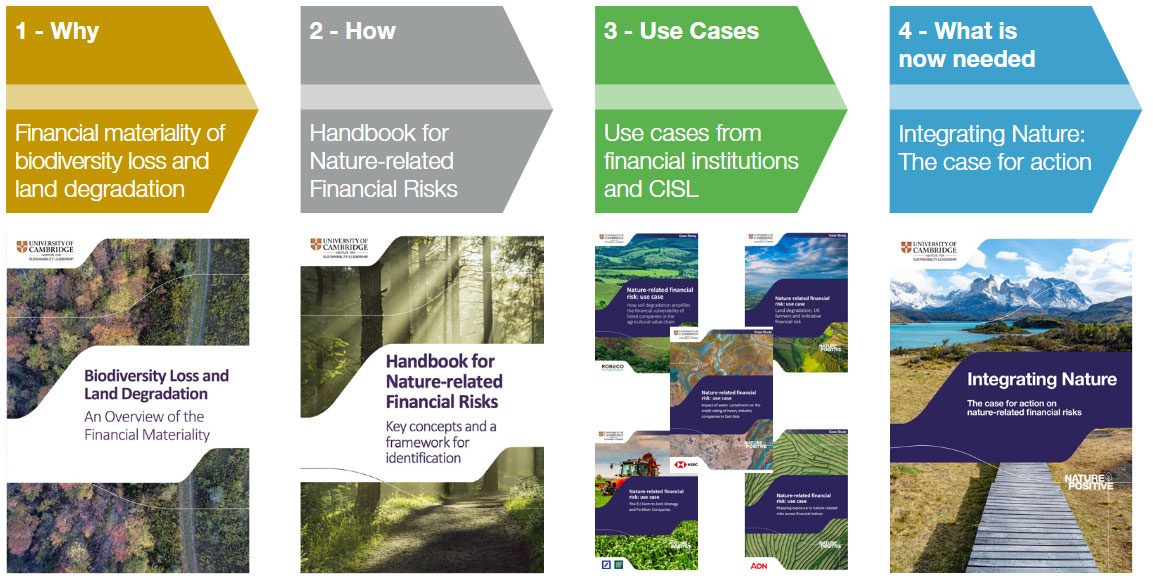
Implementation Resources
TNFD Forum Webinar: Nature-related risk in practise
Watch the Taskforce on Nature-related Financial Disclosures (TNFD)’s April 2022 Forum webinar for a deep-dive into our use cases conducted in collaboration with leading financial institutions. Dr Nina Seega (CISL) is joined by practitioners Matteo Oriani (HSBC) and Stephen Verheul (Robeco) to discuss use-cases that quantify and assess specific nature-related financial risks. The webinar was moderated by Taskforce member Snorre Gjerde (NBIM) and also features Dr Simon Zadek (F4B) discussing the Integrated Transition Framework by the Finance for Biodiversity Initiative (F4B).
Watch the webinar here.
Valuing nature in financial decision-making
We have created a 5-minute briefing for senior managers to gain an understanding of our nature-related finance research and what's needed now.
Download the briefing here.
Connecting finance leaders with Cambridge academics
A steering group of ten global banks and leading investors is co-delivered this programme of work, drawn from members of the Banking Environment Initiative and Investment Leaders Group. Individuals on the steering group bring a range of expertise, with titles including:
- Head of Asset Allocation
- Global Head of Chief Investment Office
- Head of Responsible Investment
- Head of ESG Research
- Positive Impact Fund Manager
- Global Head of Sustainable Finance
- TCFD Implementation Manager
- Head of Sustainability Strategy
- Climate, Environment and Emerging Issues Lead
In addition to this team, we were joined by academics from the University of Cambridge conservation cluster, the largest of its kind worldwide, and supported by the CISL Business and Nature team:
- Dr Anthony Waldron, Lead author on the 30 x 30 Economic Analysis project at the Cambridge Conservation Initiative
- Dr Matthew Agarwala, Lead on the Wealth Economy project at the Bennett Institute for Public Policy
- Dr Gemma Cranston, Director of CISL’s Business and Nature Team
The programme was led by CISL's Centre for Sustainable Finance (CSF), with direction from Dr Nina Seega, Director of CSF and leading expert in the field of environment risk assessment in financial decision making.

